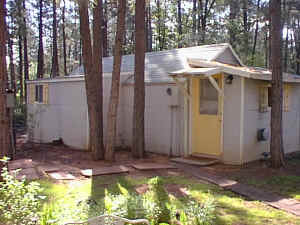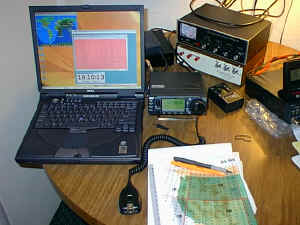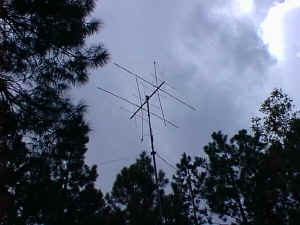 |
 |
 |
| Cabin in the Woods | Portable Station | 6/2 Meter Quad @ 28' |
Operation (July 7-9) 2001
Greg Ordy, W8WWV
From July 7th through the 9th, 2001, I was part of a portable operation located in Lakeside, Arizona. The primary goal of this junket was to operate on 6 meters. Hopefully, we could catch some openings around the solstice.
I would like to thank Vince, NE7Y, for joining the operation. His time and experience were invaluable. Being from the nearby Phoenix area, an avid outdoorsman, and a long time amateur radio operator, he helped make the whole operation go quite smoothly.
The location of Lakeside Arizona was chosen because it was located in grid square DM54. From several activity reports I found on the Internet, that square seemed to have few active 6 meter operators, and it was relatively close to Phoenix, a city with a major airport, and several friends. It also seemed to be a mountain/forest region, as opposed to Phoenix, which is a hot, dry, desert (especially in the summer months). This change in climate and scenery would provide a pleasant contrast across the trip.
From a GPS receiver, the exact location of our transmitter was:
W8WWV/7 DM54 Location |
|
| Latitude: | 34º 8' 47.2" N |
| Longitude: | 109º 59' 6.1" W |
Elevation: |
6820 feet |
In checking 6 meter activity reports, it appeared as if grid squares DM53, DM54, and DM55 were all relatively rare. The one square that was not at all rare was DM43, which contained the large city of Phoenix. In order to get into the DM50's, one needed to cross over to the eastern side of the 110º longitude line.
When I first casually checked a highway map, it appeared that any location east of the town of Show Low would definitely be over the line. Show Low is at the western side of a number of small towns located on top of the ridge. This range extends towards towns like Greer, which at 9,000 feet is a popular skiing destination. When I arrived in Phoenix, I happened to see a more detailed map, and upon closer inspection, the destination city of Lakeside appeared to be very close to the line - too close. If it were to be over the line (to the west), our grid square would have been DM44. While not as common as DM43, much of the population of Arizona does run up and down the center of the state (around route 17), and DM44 is directly over that corridor.
With all preparations made, all I could do is wait until we arrived, and check the exact location with a GPS receiver.
While setting up the station, we turned on the GPS and waited anxiously to see the results. Our longitude was 109º 59' 6.1". We were only 53.9 seconds over the line! In other words, if we were 53.9 seconds of longitude further west, we would be in the next grid square. I never thought that it would be this close. The lesson learned is to check out the maps in far more detail, or simply not be that close to a grid line boundary. In most of the continental United States, a grid square is approximately 70 by 100 miles. We were approximately 3,000 feet from the boundary. After driving almost 200 miles from Phoenix, we were in the next column of grid squares by 3,000 feet.
I have described the general organization of my portable station on another page. I carried the ICOM 706MIIG and the Dell laptop computer with me on the airplane. The rest of the equipment was shipped via UPS. It broke down into two boxes. The antenna tuner, power supply, GPS, and assorted cables fit into a 14" X 14" X 14" box that weighed approximately 30 pounds. The antenna mast and 6/2 meter quad antenna fit into a 6" X 6" X 72" box that weighed approximately 20 pounds.
It took about 90 minutes to set up the station, and a similar amount of time to tear it down.
The cabin was located within a dense grove of pine trees. This was good news and bad news. The good news was that the center of the HF dipole was hung off of a tree at around the 35 foot level. This was more than high enough to provide good performance on all HF bands. The bad news was that it was a little tricky to find an area to assemble and then walk up the 28 foot tall aluminum mast that had the quad on top.
The three feed lines, as well as a grounding wire were fed through an open window. A round table was located right under the table. In many ways, it was an ideal situation.
Here are some pictures of the portable station. Please click on a picture for a larger view.
The left picture shows our cabin in the woods. The quad antenna was located in a small clearing to the left of the cabin. The high density of trees only left us with one viable location for the quad. Since the quad was rotated by hand, this was a little inconvenient, in terms of the time necessary to go outside, rotate the antenna, then return to the station.
The portable station is shown in the middle picture. The 23 amp switching supply is located behind the radio. Vince, NE7Y, brought along his TS-50 and MFJ antenna tuner. His radio is on the right side of the picture, and his MFJ-949 is stacked below mine. My tuner did suffer some external case damage in shipping, and there was some concern that it might not work correctly. In the end, it was electrically fine, but we did have two tuners on the table (just in case). An Autek RF-1 can be seen lying on the table. This was used to pretune the HF dipole through the tuner.
Finally, the 6 and 2 meter Cubex quad is shown in the right picture. It was placed on top of a 28 foot tall aluminum pole. This antenna and mast is described on my Portable Station page.
Good propagation on 6 meters is never guaranteed. During our time at the station, there were two good bursts of activity. Most of the time, conditions were marginal. In checking the packet spots, it appeared as if there were good openings on each side of my trip. Here's a grid square map showing the squares I worked.
My DM54 square is shown as a blue circle. Single and double hop E-skip propagation would appear to account for the large number of stations worked in the Texas and Florida areas.
We worked about 75 stations on 6 meters. While I would have preferred to work many more, at least we were not wiped out due to poor propagation. There's always the next time.
Although this page is about the radio operation, I really must mention that the scenery was simply beautiful. Our trip was in the shape of a large loop. We left Phoenix (1,000 foot elevation) on route 60, heading due east. After passing Globe, an old copper mining town, the route turns northeast, and climbs up to over 7,000 feet. As one moves from Phoenix to the mountains, the scenery and climate changes drastically and dramatically. The ride back to Phoenix went west out of Show Low, along the top of the Mogollon Rim, through Payson. This stretch of road rises to over 8,000 feet. Please click on a picture for a larger view.
Of course the spectacular Grand Canyon is only about 120 miles northwest from this general area.
I learned quite a bit from this experience, especially with respect to 6 meter operation.
Back to my Portable Operation Page